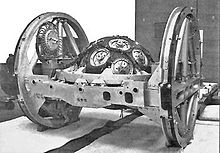- Orange Herald
-
Orange Herald was the name of a British nuclear weapon of the 1950s.
Contents
Technical
Orange Herald was a fusion boosted British fission nuclear weapon, comprising a U-235 primary surrounded by lithium deuteride. 'Herald' was suitable for mounting on a missile, utilizing 117 kg of U-235. However, Britain's annual production of U-235 was only 120 kg at this time, which would have made such weapons rare and very expensive.[1]
Two versions were designed - an "Orange Herald Large" with an overall diameter of 39 inches (1.0 m), and an "Orange Herald Small" with overall diameter of 30 inches (0.75 m).[1]
The Orange Herald Small version was tested once, yielding 720 kT of explosive power on 31 May 1957, during the Grapple 2/Orange Herald tests on Malden Island in the Pacific.[2] Orange Herald remains the largest fission device ever tested.
It is thought that the fusion boosting failed to increase the yield. A higher compression but smaller fission pit American weapon, the Mark 18 Super Oralloy Bomb, had a yield of 500 kilotons from a pit with slightly over 60 kilograms of highly enriched uranium, around 8 kilotons per kilogram of uranium, about the practical maximum 50% fission yield efficiency for very large or very highly boosted fission weapons. Even with less compression, the larger 117 kg pit of HEU in the Orange Herald Small should have had a roughly similar efficiency - the observed 720 kiloton yield equals over 6 kilotons per kilogram of uranium.
Orange Herald was the first British nuclear device to use an external neutron source.[3]
Britain rushed the development of these predicted-megaton class weapons because in 1955 it seemed that atmospheric testing could soon be outlawed by treaty. As a result, the UK wanted to demonstrate its ability to manufacture megaton class weapons by proof-testing them before any legal prohibitions were in place.
It is believed by some that the large requirements of fissile material that Orange herald needed was a major cause of the Windscale fire. It was unpopular with the scientists who worked on the project. One of the workers in the British nuclear program is quoted as saying "I thought that Orange Herald was a stupid device. It wasn't elegant, it was a dead end design and couldn't be taken any further".[4] This is the major thesis of a notable BBC documentary on the topic of the fire Windscale: Britain’s Biggest Nuclear Disaster.
See also
- Rainbow Code
External links
References
- ^ a b The Real Meaning of the Words: A Very Pedantic Guide to British Nuclear Weapons Codenames
- ^ British Nuclear Testing, Carey Sublette, at nuclearweaponarchive.org. Accessed 2009-04-28
- ^ http://www.awe.co.uk/main_site/about_awe/history/timeline/1957/index.html[dead link]
- ^ Windscale. Britain's biggest nuclear disaster (2007)
Air-to-air missiles Blue Sky (Fireflash) · Blue Jay (Firestreak) · Red Dean · Red Top · SRAAM · Skyflash
Air-to-surface missiles Blue Steel · Green Cheese
Surface-to-air missiles Surface-to-surface missiles Blue Slug · Blue Streak · Blue Water · Blue Rapier / Red Rapier · Orange William (Swingfire)
Satellite launch vehicles Nuclear warheads Blue Danube · Blue Peacock · Orange Herald · Red Beard · Red Snow · Violet Club · Yellow Sun
List of codenames used for projects (Rainbow Codes) Categories:- Nuclear bombs
- Weapons of the Cold War
- Nuclear weapons of the United Kingdom
- British nuclear explosive tests
- Rainbow Codes
Wikimedia Foundation. 2010.


